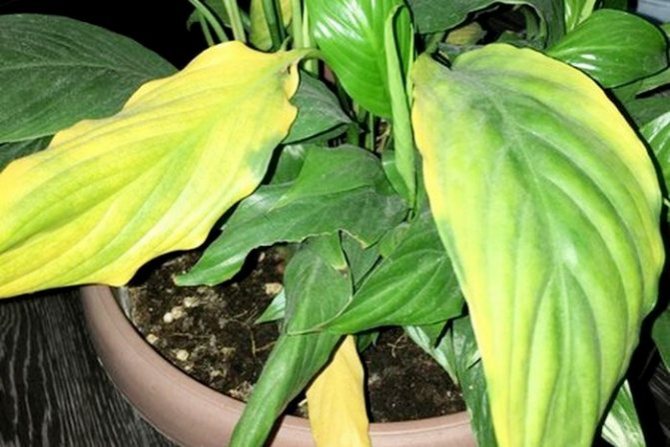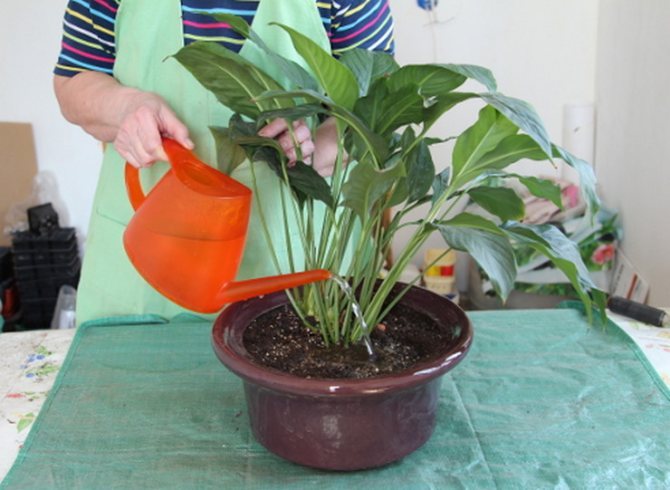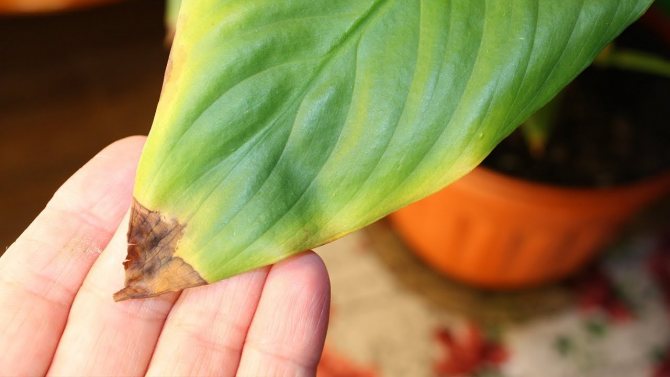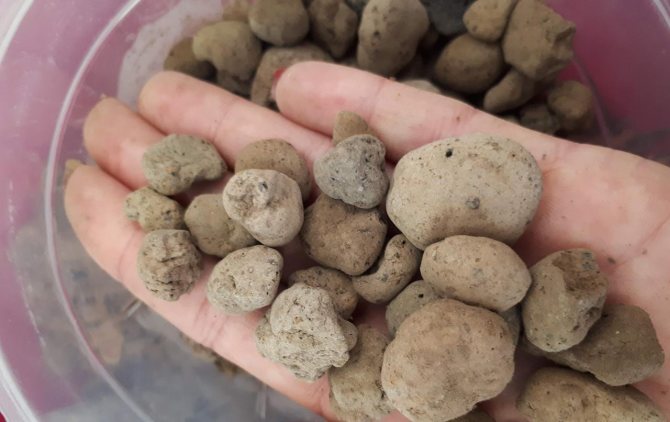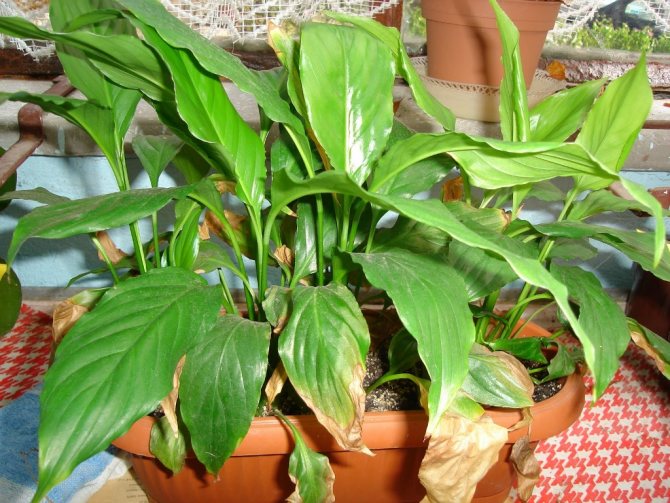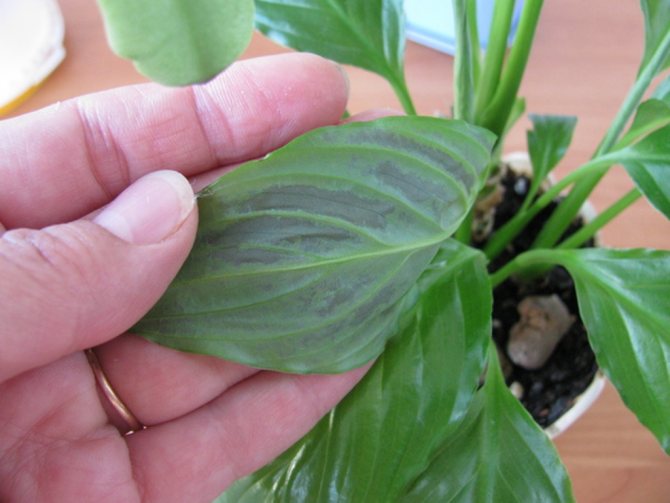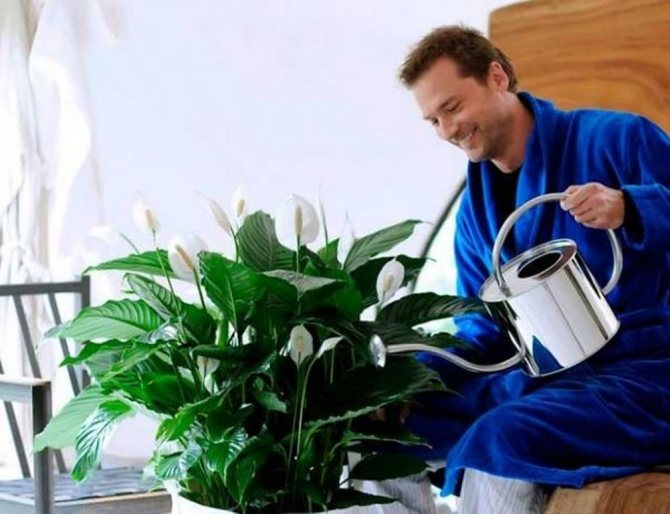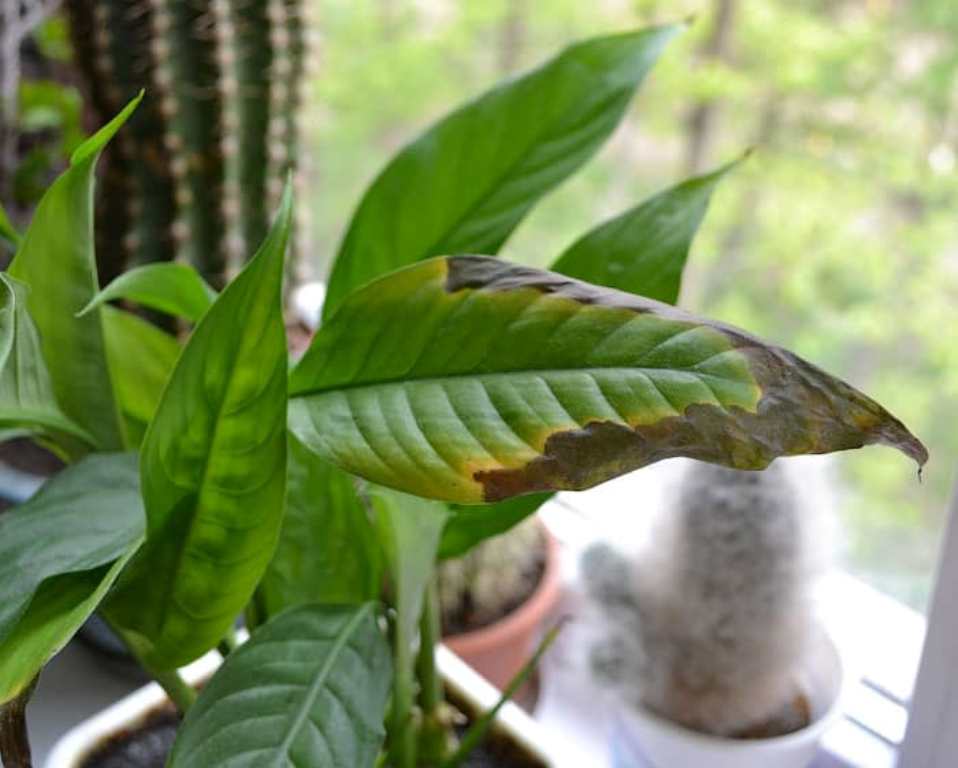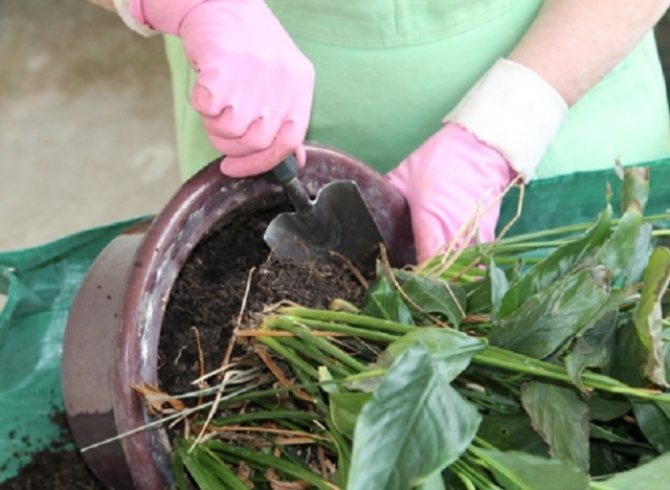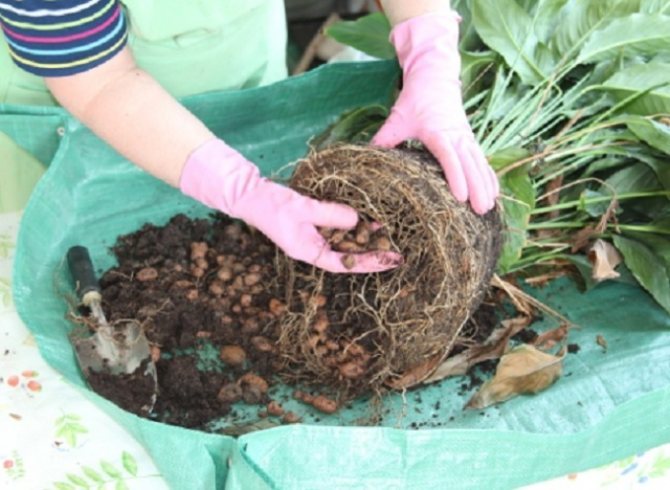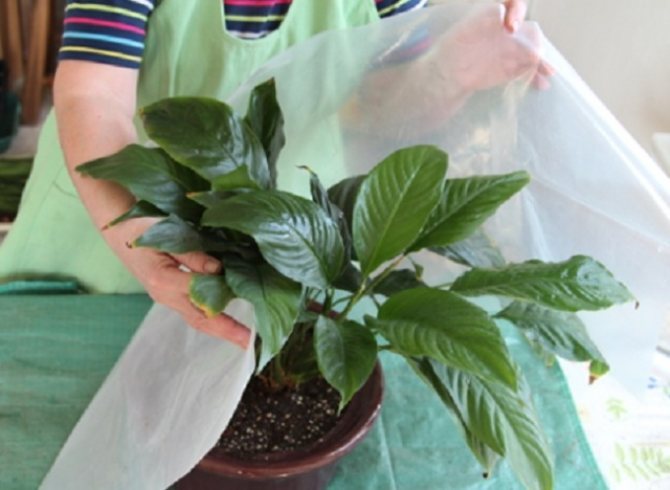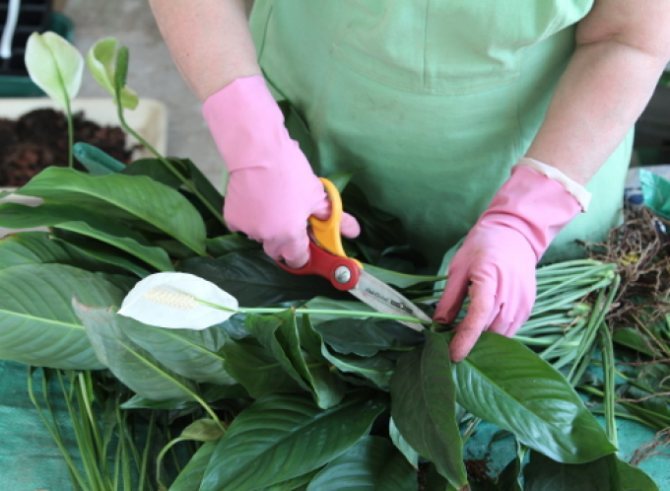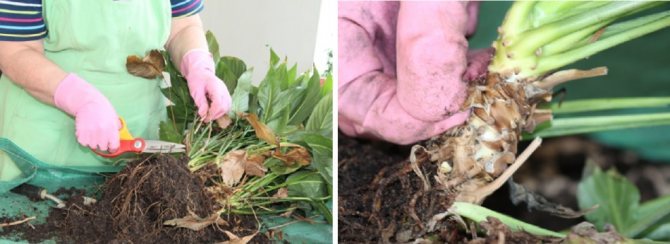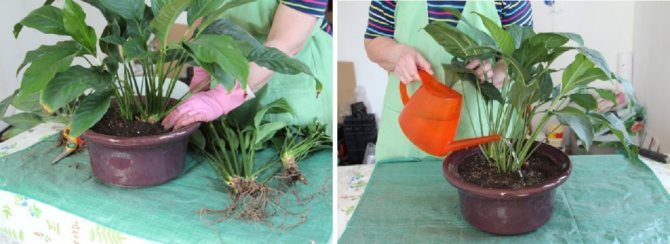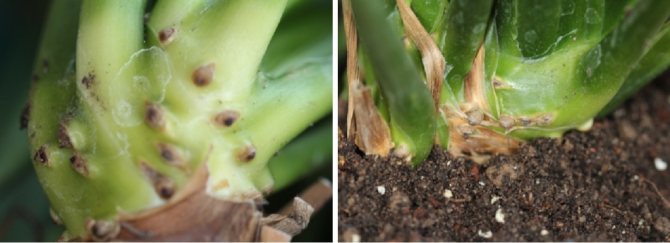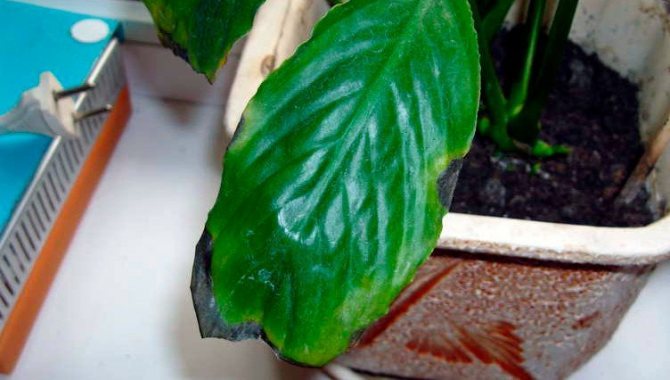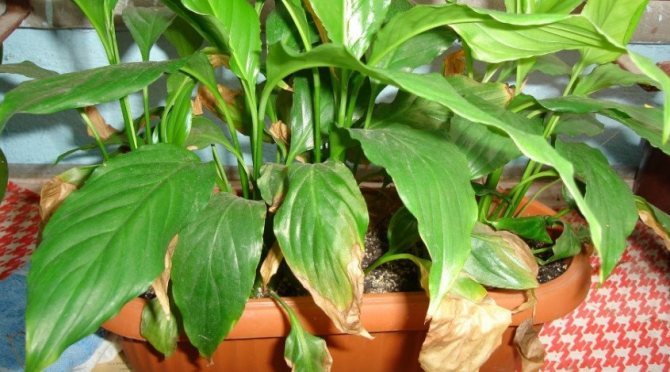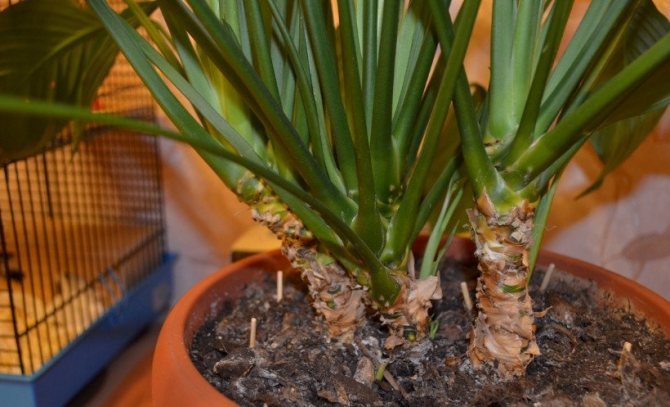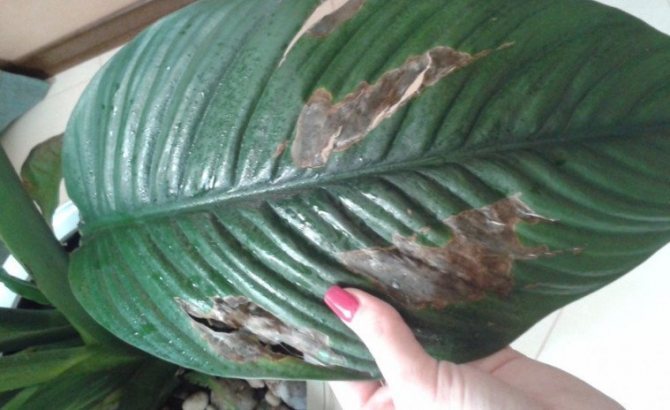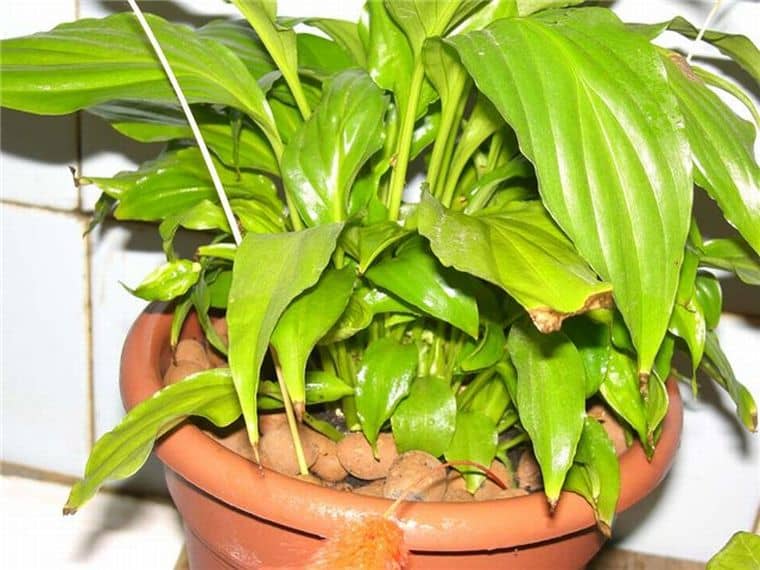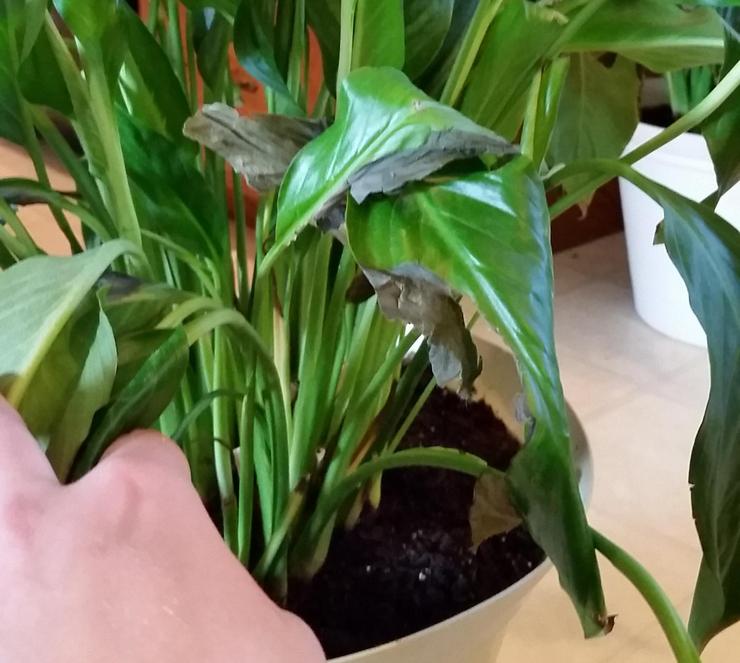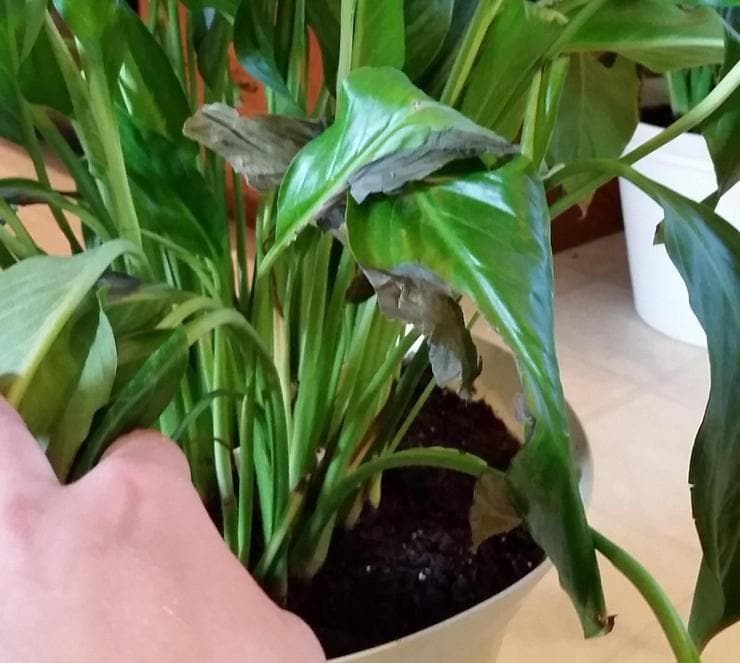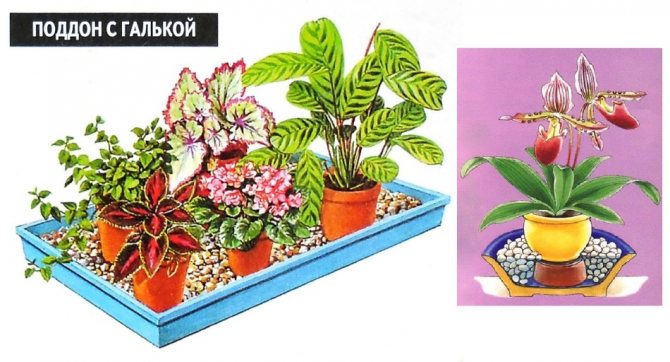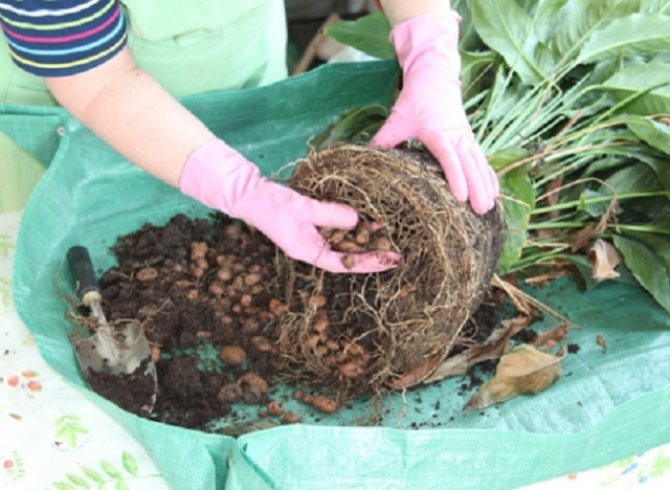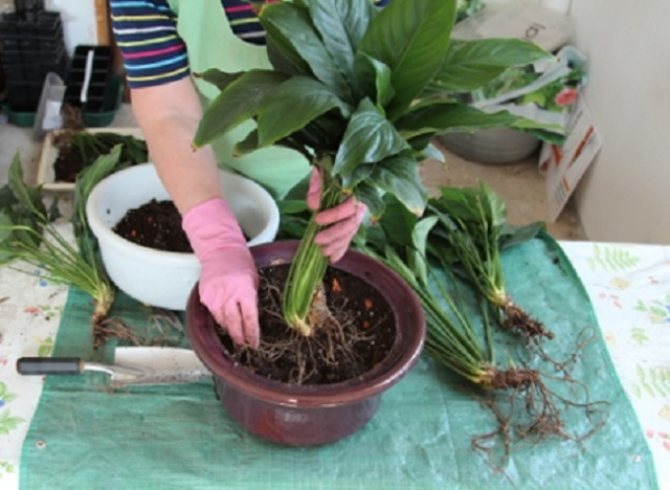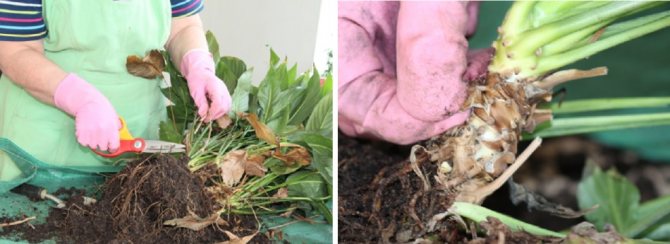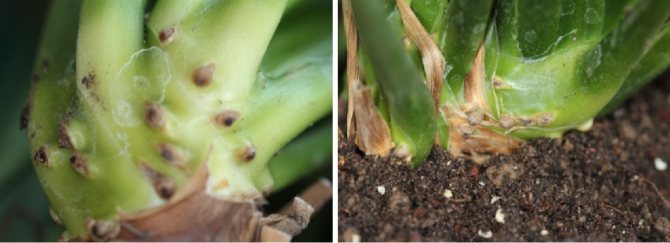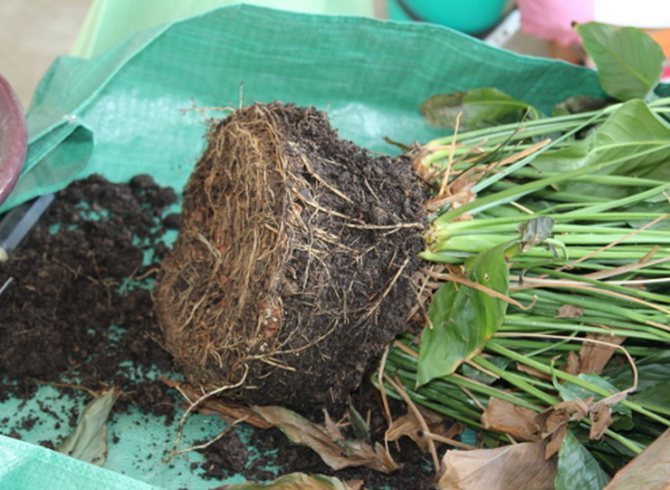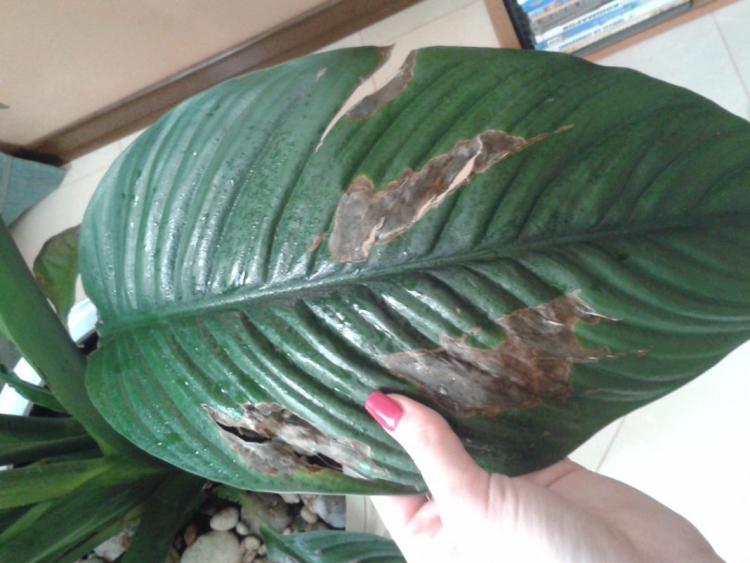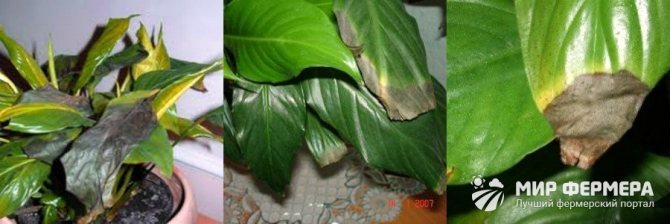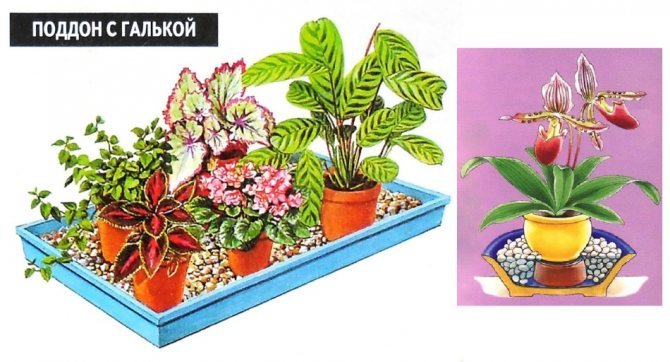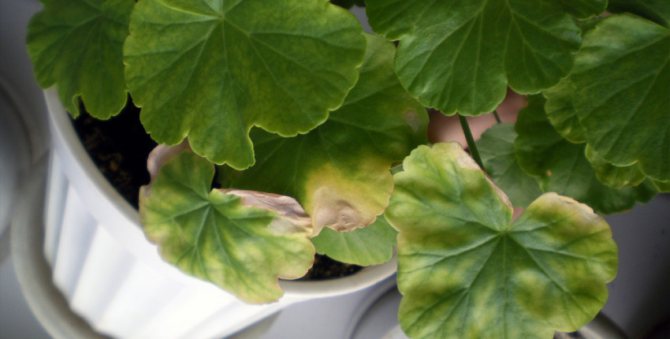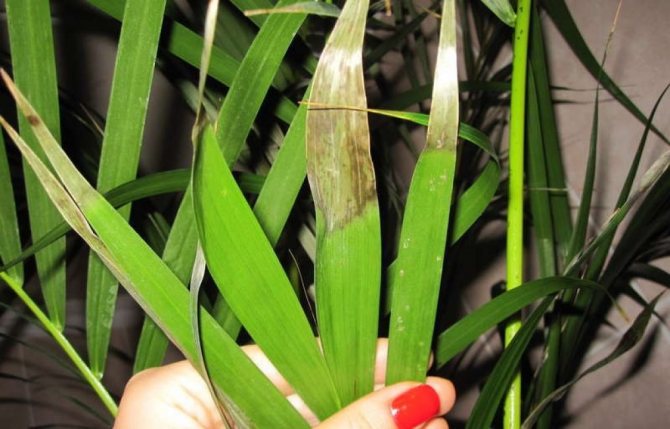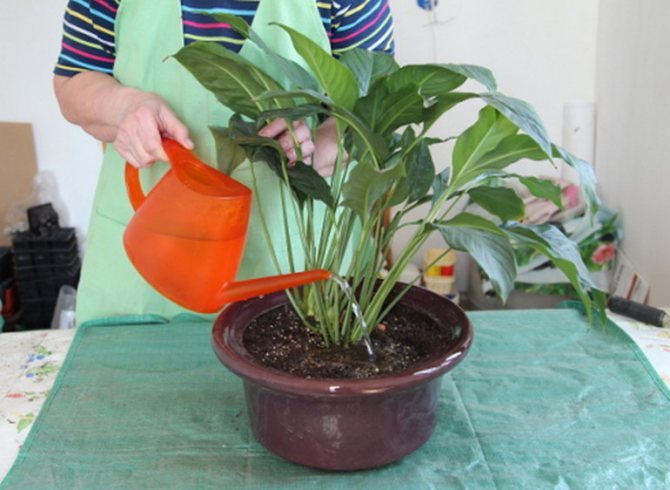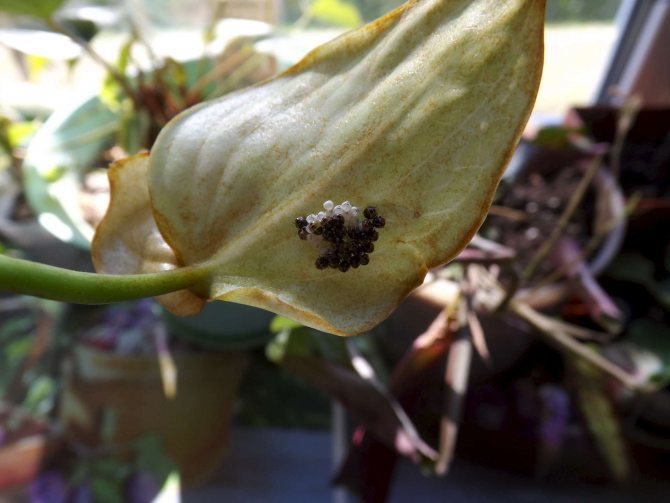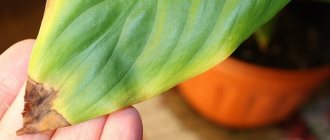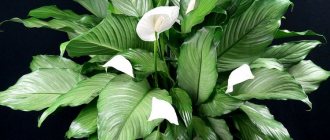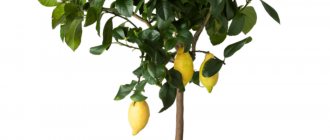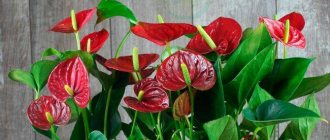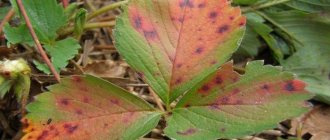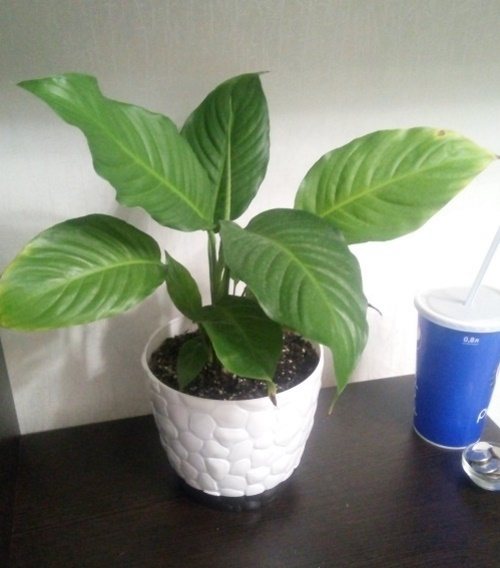
Large bright leaves of pure green color with as if painted with clear veins, towering above the pot on strong legs - this is a handsome spathiphyllum. A very beautiful ornamental plant becomes even more beautiful during flowering, releasing a long peduncle with a snow-white veil. In general, such a flower is not particularly capricious, but some difficulties can still arise.
Yellowing and blackening of spathiphyllum leaves is one of the most common problems. There can be several reasons for this phenomenon, both individually and in combination, namely:
- violation of the watering regime;
- inappropriate conditions of detention;
- lack of nutrition;
- the presence of diseases.
Top dressing and transplanting - the necessary care for the spathiphyllum flower


Yellowness on the leaves of a recently healthy green bush appears quickly and can be a sign of a variety of problems. Due to the similarity of symptoms, even experienced hobbyists rarely manage to immediately find the reason for this plant behavior. But you cannot hesitate, since the death of foliage entails a general weakening of the spathiphyllum, and sometimes it can signal irreversible putrefactive processes on the roots.
Most often, the source of problems with spathiphyllum is in the care of the flower, or rather, in the lack of attention to the plant.
If the plant has bloomed for a long time and abundantly, yellowing leaves can mean fatigue of the bush, which has wasted all the strength and available nutrients. In this case, the foliage from the lower tiers first begins to experience a similar deficit, evenly changes color, and then withers.
Top dressing can help the plant, and if the yellowed spathiphyllum has not been transplanted for a long time, then transfer it to a new, looser pot with nutritious loose soil.


In the future, in order to avoid similar problems, you need to feed the plant twice a year and, if necessary, in the spring, transplant the bush into a pot in size.
Why is this happening
The most common reason why spathiphyllum leaves turn black is a lack of proper care. In most cases, blackness indicates root damage. If the tips of the leaves are blackened in spathiphyllum, most likely the flower is being watered incorrectly, and the problem may also be in the wrong substrate.
Excess moisture


Women's happiness needs regular watering. It is desirable that the soil is kept moist, but at the same time, moisture stagnation should be avoided. When the root system is constantly in wet soil, it begins to rot. This is evidenced by the blackening of most of the leaf. Black edging appears on the inflorescence.
In the summer, the spathiphyllum flower should be watered abundantly once every 3-4 days. In winter, the plant prefers moderate watering, once a week is enough. The flower is watered when the top layer of the substrate dries up.
In spathiphyllum, the leaves turn black in case of infection with fungal infections, which primarily affect the root system. Their development is facilitated by moist soil and low air temperatures. Weeping, loose blackness appears on the infected parts of the plant, sometimes together with the manifestation of brown spots or specks.
Hypothermia
Another reason that the tips of the leaves of Feminine happiness dry out may be that the flower is freezing. Spathiphyllum is a thermophilic plant. It does not tolerate drafts and sudden temperature changes, as can be seen from sagging foliage and darkening of inflorescences. With light freezing, the flower will recover, only black tips will remain. If the plant is frozen when it was wet, it may die.
The roots can freeze if spathiphyllum is watered with cold water in winter. In this case, decay of the root system will begin, blackening of the foliage and dried tips of the leaves will begin to appear. Therefore, the water used for irrigation must be at room temperature.
You also need to monitor the air temperature in the room with the flower. In the summer season, it should correspond to a mark of 20-29 degrees. In winter - at least 15.
Since Women's happiness is a tropical plant, it needs high humidity. Large leaves are involved in the process of gas exchange, as a result of which a lot of moisture evaporates, which must be compensated. Therefore, the plant needs to ensure not only proper watering, but also spraying with soft, well-settled water at room temperature.
The procedure for spraying and washing Women's Happiness should be carried out throughout the year. In the summer season, it helps to clean the plant of dust and saturate it with moisture, in winter it maintains the humidity of the air at the required level. In addition, it is also pest prevention.
Often, the result of the leaves of spathiphyllum turning black may be an excess of fertilizer. Their shortage also adversely affects the flower. When overfeeding, the root system is not able to cope with the excess amount of nutrients, which often leads to rotting, which causes blackening of the upper parts of the plant.
In the case of overfeeding, you will need to transplant into a new substrate, while cutting off rotten and damaged roots, and other parts of the spathiphyllum. The transplanted plant is fed as usual.
Fertilizers are applied twice a month by foliar method. Female happiness reacts well to organic matter, therefore it is recommended to alternate it with mineral fertilizers. It is important to use the drugs according to the instructions and in no case increase the dosage. In the winter season, spathiphyllum is at rest, so you should stop feeding it.
You do not need to fertilize the flower immediately after purchase, as usually in flower shops the plant is planted in soil saturated with nutrients.
The black color of various plant organs is certainly associated with a deterioration in the health of the spathiphyllum. Outwardly, blackness looks different.
- The tips of the leaves dry up and turn black, and a large area of brown appears along the edges. Over time, the places become dry, brittle. The foliage withers and falls off. If it does not fall, then the appearance of the plant still loses its decorative effect. This is "dry" blackness.
- There is also a "sluggish" or weeping blackening. Black leaves become wet, soft, slippery, and have lost their density. Often this phenomenon has an extensive nature of distribution, perhaps fungal spores and mold appear over the affected area.
Reference! In spathiphyllum, the tips of the leaves, the entire plate, roots, and inflorescences may turn black. Depending on the cause, the area of the damaged area can grow quite quickly.
Lighting for spathiphyllum
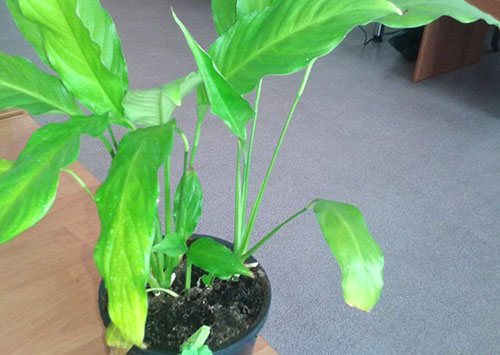

Spathiphyllum turns yellow when it is in uncomfortable conditions for a long time. Most often, flower growers make the mistake of exposing the pot to direct sunlight.Although spathiphyllum is very light-loving, scorching, especially the summer sun, becomes the cause of yellowness and even burns of leaf plates. But with a lack of sun, spathiphyllum reacts with a slowdown in growth and pallor of the leaves.
If in summer the main enemy of the plant is the bright sun, then in winter excessive dryness of the air is destructive for the spathiphyllum.


When the pot is located near heating appliances, it is unlikely that the aboveground part and yellow ones will fade away. Yellowing and then dying off of the leaf begins from the tip, gradually spreading and occupying most of the leaf plate. As a result, the plant weakens, stops flowering ahead of time and may die.
Therefore, wanting to see the plant healthy and beautiful, you can:
- remove spathiphyllum away from the battery;
- put a container of water next to it;
- use a humidifier;
- use a spray bottle to spray the plant.
In any case, the plant will respond with lush greenery. Slightly damaged leaves regain their previous color, and leaf plates that have begun to dry are best removed so that they do not become a breeding ground for harmful fungi and pests.
Improper care or conditions of detention
Often absolutely healthy spathiphyllum suddenly begins to turn yellow, or just wither. Such a flower reaction may indicate the presence of a variety of hidden problems. It is impossible to leave what happened without attention, as you can lose the plant. Therefore, the first thing you should do is to revise the conditions of its containment, since not adhering to them is one of the most common reasons for the appearance of yellow foliage.
Dry air
If there is insufficient air humidity in the room where spathiphyllum grows, then the tips of the leaves begin to turn yellow. The color changes only in an insignificant part of the leaf (1-2 mm). The rest of the leaf plate remains a natural green color. A yellow stripe may appear in the border area. If you do not take timely measures, then the yellowness gradually turns into blackness and spreads to the entire leaf. Ultimately, it dies off.


An increase in humidity will help to correct the situation. To do this, spray the plant twice a day with warm soft water, place a container with water near the pot, or pour wet expanded clay into the pan.
Did you know? The genus of plants Spathiphyllum got its name from the merger of two Greek words σπάθη (veil) and φύλλον (leaf), since its bracts are similar to a veil.
Direct sunlight
Spathiphyllum is very fond of light, but if the sun's rays fall on its leaves, they will leave burns. They look like spots or stripes with a yellow tint and with a thinned surface.
In bright light, the color of the leaf plate will gradually change: from deep green to yellowish-green, which can completely turn into colorless.
Such a plant urgently needs to be rearranged to another place, either create a shadow on the old one, or move it away from the window. If possible, it should be placed on the north, north-east, north-west or east windows.


Lack of nutrients
When a plant lacks nutrients, its foliage begins to change color unevenly. Most often, this color resembles a mosaic: green spots are scattered over a yellow background, or vice versa. The veins may also lose their color, or only they will retain their natural shade. Most often, this indicates a lack of elements such as boron, calcium, iron.
To correct the situation, you need:
- change the soil in the pot to light, loose and slightly acidic;
- spray the flower with iron chelate (if the vein color has changed) or feed it with a mineral complex (in other cases);
- 2-3 weeks after transplanting, apply complex fertilizers;
- water the flower with warm soft water and spray twice a day.
Important! Most often, spathiphyllum lacks nutrients during flowering, since this period is quite long and energy-intensive. Therefore, you should regularly feed the flowering plant.
Improper watering
With improper watering, the plant may experience both excess moisture and its lack. In the first version, the leaves begin to dry and turn black in large pieces. These may be just brown or black spots or discoloration of the tip of the foliage. Such changes appear due to the fact that the root system is constantly freezing. Reduce watering so that the ground dries well, then water only when the topsoil is 1 / 3-1 / 4 of the depth dry. If the spots continue to spread, then most likely the root system has already begun to rot.
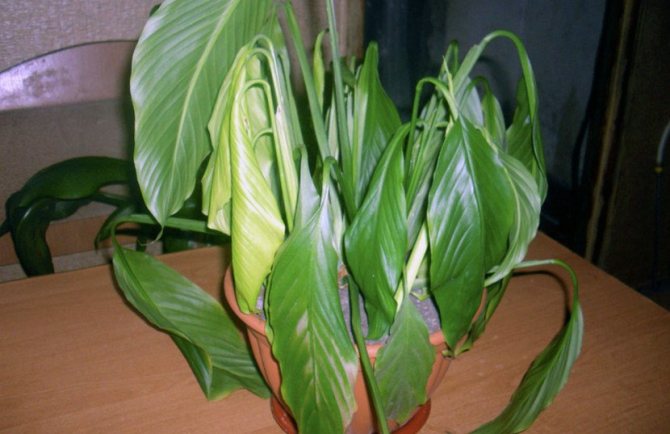

Then the spathiphyllum needs to be urgently removed from the pot, rinsed the roots in water to free them from the earth and carefully examine them. Affected roots will be yellow or brownish in color, and soften to the touch. Healthy white, elastic. The affected part of the root system must be cut out, and the sections must be lubricated with activated carbon powder. Then leave the flower to dry for two or three hours. After landing in a new land mixed with activated carbon. After two to three days, water the plant with warm, settled water.
If the spathiphyllum lacks moisture, but its leaves begin to wilt, and if it is not watered in time, then it will turn yellow. Drought is less dangerous for a flower than waterlogging, but it is often not recommended to arrange it for a long time. Noticing that the plant has withered, it needs to be watered. If after a few hours the leaves did not become tight, then the soil is probably very dry or there is a lot of peat in it, then you need to place the flower pot in a container with water so that its root system draws moisture from below. It will be enough to hold the spathiphyllum for 15–20 minutes.
Hypothermia
The plant reacts to drafts or low temperatures by changing the color of the foliage (the appearance of a yellow tint along the edge). There may be another variant of the reaction to cold - blackening of the leaf plates.
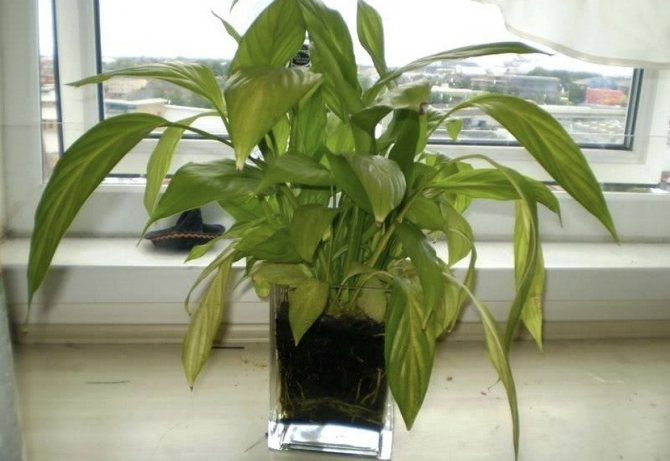

This happens due to the cooling of the horse system through moisture. Most likely, you watered the flower in the evening, and at night the temperature dropped dramatically, so the roots froze. It is necessary to rearrange the flower in a warmer place, protect it from drafts and not water it overnight. To make him recover faster, he can be sprayed with an anti-stress agent, such as "Epina".
Untimely transplant
Transplanting plants is needed so that the overgrown root system receives enough nutrients. If the roots have completely filled the pot and begin to fall out of it, then the flower has nowhere to receive nutrients, since the soil is already depleted and it slowly begins to die.
Read more about the features of the choice of soil for spathiphyllum.
His old leaves turn yellow, young ones grow small, there is no flowering. Therefore, urgent action is needed so that the plant does not die at all.
- First, choose a pot one and a half larger than the old one.
- Fill it with fresh nutrient soil, not forgetting the drainage layer.
- Gently remove the flower from the pot, free its roots from the ground, being careful not to cut off the small roots.
- Place the flower in a new pot, spread the roots and top up the soil. It is not necessary to deepen the growth point.
- Feed Spathiphyllum for a month after transplanting.
Spathiphyllum turns yellow due to a violation of the irrigation schedule
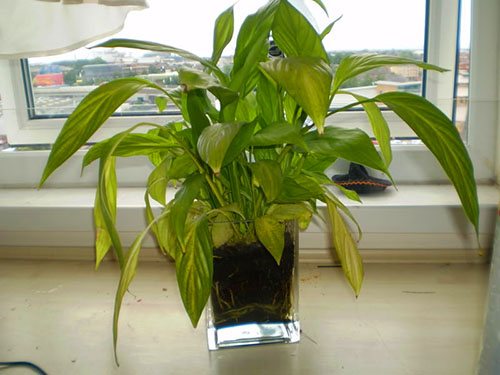

If the leaves turn yellow in spathiphyllum, and the color change begins from the edges of the leaf plate, on which a dried black border is formed, this may be a flower's reaction to a violation of the watering regime:
- With a lack of moisture, the earth dries up and does not provide the plant with proper nutrition.
- Excessively moist soil, especially at a rather low indoor temperature, is a serious risk of developing rot and fungi parasitizing on spathiphyllum.
It is optimal if the substrate is constantly wet, but moisture stagnation should not be allowed.
Therefore, in winter, the intensity and frequency of watering is reduced. And in the summer, when the need for moisture increases, to reduce evaporation, the soil is mulched with pebbles or sphagnum moss.
Drying out the tips of the leaves
Drying of the tips of the leaves in an insufficiently humid environment in spathiphyllum, "standard" for any moisture-loving plant, appears as a dry, dark speck at the point itself. Most often, it almost does not affect the main leaf blade, not so much affecting the decorative effect.
So spathiphyllum reacts to extremely dry air (in general, the plant tolerates the usual average conditions of living rooms much better than competitors), but not only. The tips of the leaves of spathiphyllum can also dry out with unstable, constantly changing humidity in the air or soil.
It is difficult to avoid drying out the tips of the leaves without measures for installing any kind of humidifier and creating a stable humidity, it can manifest itself even with frequent spraying.
It is easy to prevent the phenomenon: in rooms with dry air and operating air conditioners or heating systems, it is enough to place bowls and pallets with damp materials nearby. You can group plants with moisture-loving counterparts around humidifiers and shower more frequently.
Other measures are also important:
- hygiene, prevention of dust accumulation on the leaves of spathiphyllum;
- protection of spathiphyllum from direct proximity to heating devices.


By drying the tips of the leaves, spathiphyllum reacts to extremely dry air. <>
Deficiency of trace elements - the cause of yellowing of spathiphyllum
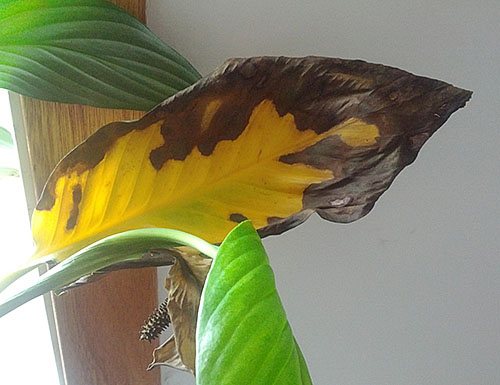

What to do if spatiffillum leaves turn yellow entirely? Most often, this symptom can be considered a sign of a lack of nutrition or a deficiency of certain elements in the soil. An ambulance in this case is feeding with complex fertilizer for indoor plants. If the roots of the flower are completely entwined with an earthen lump, then it is better to immediately transplant the plant, and, if necessary, divide a large bush.
Spathiphyllum is very sensitive to magnesium deficiency. Deficiency of this element leads to stunted growth and lethargy of the plant. In this case, the leaves of spathiphyllum turn yellow in such a way that the veins remain green, and the tissues between them become yellow or brown. Such bushes are fed with magnesium sulfate.
Drying yellowed leaves
Drying of the leaves, which begins after or simultaneously with their yellowing, indicates insufficient watering and frequent strong overdrying of the substrate. Spathiphyllum does not react very well to droughts: if the substrate dries out completely, the leaves wither, lose turgor, but only the tips dry out and the plant recovers.
If the leaves turn yellow, this is a sign of systemic disorders. In an effort to restore the plant, you should not resort to too abundant watering. The best strategy is to water more frequently and gradually restore normal average humidity.
Spathiphyllums, by drying out old leaves, also react to a lack of space for root development. If the capacity is too small, the roots have completely filled with an earthen ball, especially when a large number of daughter outlets are formed, the spathiphyllum begins to age faster, the oldest lower leaves rapidly turn yellow and dry out.
To stop this process, it is enough to carry out a transplant according to all the rules, for large groups - with a division. It should be borne in mind that such dropping of old leaves can also be a sign of preparation for flowering or "saving" resources if flowering is too long.
This can be a natural process, so you should always check the degree of filling the pot with roots and only then proceed with the transplant.
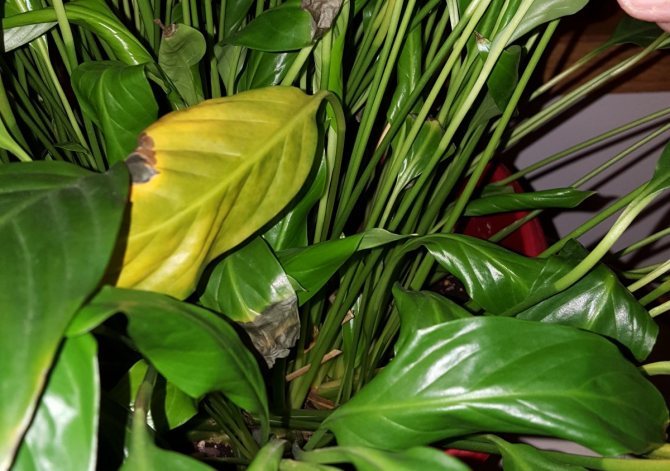

If the leaves of the spathiphyllum turn yellow, this is a sign of systemic disorders. <>
Pests and diseases of spathiphyllum
The yellowness of the foliage is not only a consequence of improper care of the spathiphyllum flower. Plants can be affected by pests and diseases, no less dangerous than lack of nutrition or root flooding.
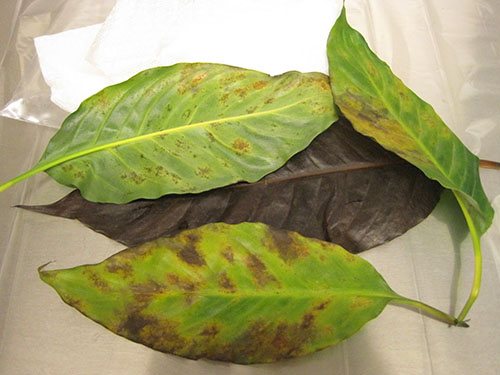

Among the pests that damage plants, mealybugs, spider mites and thrips are more common. In this case, after identifying the source of the hazard:
- the bushes are treated with insecticides;
- in the presence of soil pests, they are transplanted and fed.
As a preventive measure, it is reasonable to take only disinfected soil, which will help protect the bush from infection with harmful fungi.
It is possible to talk about a disease of fungal origin in a situation when the lower leaves of the spathiphyllum turned yellow, began to dry out, and the brown spots, growing, occupy the foliage in the neighborhood. If you do not take urgent measures, the disease will seize the stems and roots, causing irreparable damage to the plant.
What is blackening?
The appearance of blackening on any part and black leaves of the spathiphyllum indicate that the condition of the plant has deteriorated. Blackening can be dry and weeping. If the blackened parts dry out and begin to crumble, it is dry blackness. Damp blackness indicates rotting, and mold and fungal spores form on the affected part of the flower. With the deterioration of the health of Women's happiness, not only the leaves turn black, but also the flowers.
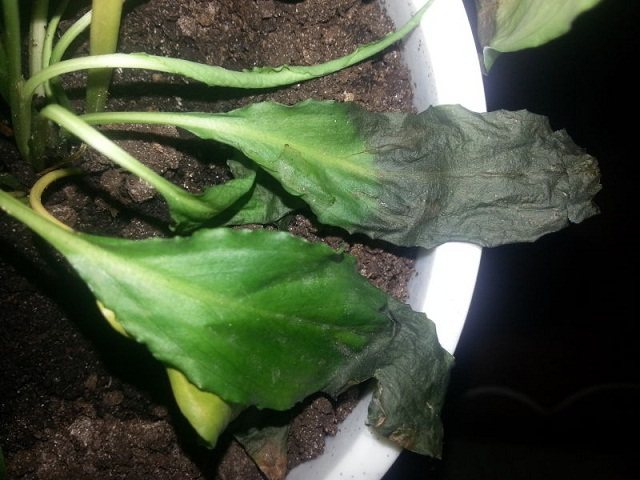

What is yellowing?
The tips of the leaves turn yellow first, and if the reasons why this happens have completely affected the spathiphyllum, then the pale yellowness will also spread to the entire leaf plate. It may also be that brown spots appear on the leaves, after which the stems begin to fade, turn yellow and dry out.
In the photo you can see the yellowed parts of the flower.
"Black" drying of leaves
This is a strong drying out of blackened leaves, starting at the tips and spreading further over time. When the upper part of the leaves is blackened, drying covers a much larger area, most often the leaf plates are gradually deformed, and where healthy tissues are preserved, the leaf turns unevenly.
This type of drying in spathiphyllum causes systemic waterlogging and root decay. Most often, the problem manifests itself in autumn and winter. At the initial stage, it is enough to adjust the watering, dry and loosen the substrate.
If the soil becomes very sour, an unpleasant odor appears and the plant is in a very depressed state, only an emergency transplant with root processing and removal of affected tissues will help to save the spathiphyllum.
"Black" drying may indicate too generous feeding. If there are no signs of waterlogging, the small tips of the leaves turn black, then it is enough to stop feeding or change the concentration of fertilizers.
Why can a plant turn yellow?
- Low room temperature or drafts.
- Wrong watering regime. Spathiphyllum, also known as "female happiness", loves a humid environment, but at the same time is sensitive to moisture accumulated in the substrate. A yellow border appears along the edges of the leaves, which then turns brown, dries up and crumbles.
- Exposure to direct sunlight.
- The lowest possible level of humidity in the room. Spathiphyllum came to us from where a tropical humid climate prevails, and therefore loves spraying, occasional showers and rubbing.
- Exhaustion. This reason can cause yellowing most often during the flowering period of the plant, when it needs more nutrients than usual.
- Pests and diseases. The yellowing of the plant can be triggered by various fungi. Their distinctive feature is a white bloom on the back of the sheet.
How does the yellowing of spathiphyllum leaves appear?
Spathiphyllum (Spathiphyllum) is a popular houseplant that has beautiful green leaves and white inflorescences. The flower is often called “female happiness”. There is also a similar plant, the anthurium, known as the "male flower". It can also be grown at home.
Yellowing of the leaves is the result of improper care
The yellowing of the leaves is an abnormal process, during which they completely or partially change color, becoming yellow, and lose their turgor.
Important! Old leaves can turn yellow and fall off - this is considered a natural process of culture rejuvenation. In this case, it is not recommended to worry.
If the violation of the shade of the leaves becomes massive, you need to pay attention to the condition of the plant and identify the causes of the problems. This will help you find the right ways to treat the flower.
In most cases, there are such types of yellowing of the culture:
- Peduncles and leaves become yellow and wither. Such symptoms indicate improper care of the plant.
- The leaves turn yellow and lose their integrity. In this case, you should pay attention to the back of the leaves. They probably contain insects.
- The leaves have changed color and wilted. This situation is observed with excessive watering.
- The leaf plates are covered with white cobwebs. This symptom indicates attacks by spider mites.
- The leaves become flabby and wither. Most often, this symptom is caused by too low room temperature.
Other symptoms that accompany the appearance of a yellow tint on the leaves include brown spots, rotting stems, mold on the surface of the earth. Sometimes the leaf plates can turn black.
When is it natural?
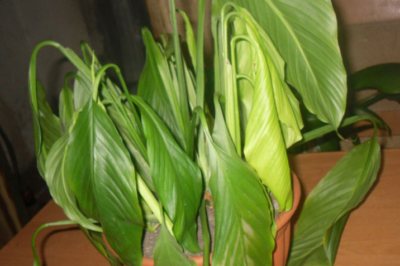

Despite the large number of reasons why a plant can turn yellow, there are also natural ones. An old plant (over 5 years old) can thus get rid of unnecessary foliage. Thus, he produces self-rejuvenation and prepares for the appearance of new leaves. You can wait until they fall off by themselves, or you can cut them off at the base with sharp scissors for aesthetic reasons.
During the dormant period (autumn - winter), the leaves of the spathiphyllum may lighten a little and become soft, but don't be intimidated. With the onset of spring, they will again become rich in color and gain elasticity. Thus, the flower accumulates resources for further flowering.
Plant shrinking
Failure to comply with the watering regime leads not only to yellowing of the leaves of the flower, but also to their drying out.
Why do leaf tips dry? Watering the plant abundantly in the hope of getting rid of the yellowness of the leaves, a novice florist can only aggravate the situation. Excess moisture causes the leaves of the flower to dry out. The plant very poorly tolerates sharp changes between frequent and abundant watering and its complete and long absence.
In spathiphyllum, the tips of the leaves also dry out due to a lack of moisture. Be sure to use only soft water at room temperature to water the plant.
Flowers can dry out due to unsuitable soil for them. By actively treating the flower with a chemical against pests, as well as not following the instructions, you can spoil the substrate. As a result: the spathiphyllum dropped its leaves and began to dry out. A lack of nutrients in the soil can lead to the same deplorable state of the flower. It is necessary to transplant the plant into another soil enriched with useful substances. When transplanting, the tips of the leaves can also turn yellow and dry. However, this is a completely normal flower response to stress and does not require anxiety.
What to do to save the flower "female happiness"?
Stem
This problem can occur with over-fertilization.
- You need to pull the earthen ball out of the pot.
- Rinse with water.
- Inspect for decay.
- Cut out the damaged parts.
- Sprinkle the cuts with charcoal.
- Transplant the remaining rhizome into new soil.
- Establish a feeding regime.
Read more about why spathiphyllum can die and how to save the plant here.
Flowers
Yellowing of inflorescences, which is rare, can be caused by various reasons, and to find the correct one, it is necessary to exclude one by one:
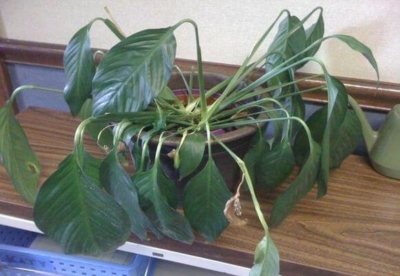

- If the pot is chosen incorrectly and the roots are visible on the surface of the substrate, then you need to transplant the plant into a larger container.
- The accumulation of moisture in the substrate can lead to yellowing of the inflorescences. It is necessary to pull out the rhizome and inspect for damage, cut them off and transplant the spathiphyllum into a new substrate.
- Fungal diseases can also cause yellowing. It is necessary to carry out the manipulations described above, but before transplanting, treat the plant with insecticidal preparations.
- Low air humidity must be eliminated by moving the plant from batteries (in winter), it can be placed in a pots with moistened expanded clay.
Leaves
What to do if the leaves of the flower "female happiness" turn yellow:
- Watering must be done correctly: water must be filtered or boiled, settled, at room temperature.
- Sprays daily with room temperature water to maintain adequate humidity.
- Maintaining a constant room temperature. In spring and summer, it should not be higher than 28 degrees, and in winter and autumn, at least 15 degrees.
- Weekly fertilizing with mineral fertilizers during the growing season of the plant.
Leaf tips
- It is necessary to inspect the substrate, and if it is dry enough, then immediately pour the prepared water.
- Spray.
- To maintain moisture, you can place a pot with a plant in a planter with moistened expanded clay.
Prophylaxis
Proper care is the main prevention., creation and maintenance of optimal conditions for growing spathiphyllum.
With the beginning of the formation of buds, it is imperative to increase the dose of dressings. You can use any complex mineral fertilizer rich in potassium, phosphorus and boron. The nitrogen content should be low.
It is important to adjust the watering regime. You can determine the need for soil moisture in the following ways:
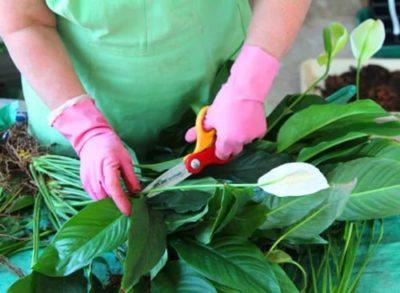

Check the condition of the soil at a depth by digging out the ground in a flowerpot.- Plant a flower in a transparent pot. The absence of condensation serves as a signal for watering.
- Place a stick without bark into the soil to the full depth of the flowerpot. Remove after 15 minutes. You can see the moisture level.
- Put special beacons in the ground that change color when humidity changes at a certain height.
In order to prevent hypothermia of the roots in winter, you need to be careful not to blow from the windows. If the room is cool, it is recommended to place a foam plate or a piece of thick woolen cloth under the flowerpot. A cork hot plate will do.
When growing spathiphyllum, you can also face such problems as the appearance of spots on the leaves, lack of growth, darkening and drooping of foliage.
Eliminating causes at home
There are many reasons why the leaves or any other part of the spathiphyllum begins to turn yellow and wither. Below we will analyze in detail the most common ones.
Improper watering


The main symptom is yellowing of the edge of the leaves and further drying out, when there is a maximum lack of moisture in the substrate. The earthy clod begins to dry out, and the roots with it, which causes the edge of the plate to turn brown. It is urgent to water the plant and spray it.
It can also happen due to the accumulation of moisture in the soil, and to solve the problem, you need to do the following:
- Remove the earthy clod from the pot.
- Rinse it with running water, thereby getting rid of excess soil.
- Examine the roots for rot, which appears when there is an excess of moisture (healthy ones are white, and infected ones are yellowish).
- Get rid of the affected roots with a sharp knife.
- Sprinkle the cut sites with activated charcoal and leave the healthy rhizome to dry for 2 - 3 hours.
- Plant spathiphyllum in a new substrate, while watering immediately after planting is not necessary.
- Water in 2 - 3 days with warm settled water.
Why do the tips of the leaves turn black in spathiphyllum - reasons
A change in the color of the leaves of spathiphyllum, drying and blackening of their tips are a signal of the destruction of the root system of the plant. This can happen if the cultivation rules are not followed or with inadequate care. The main reasons why the tips of the leaves turn black in spathiphyllum:
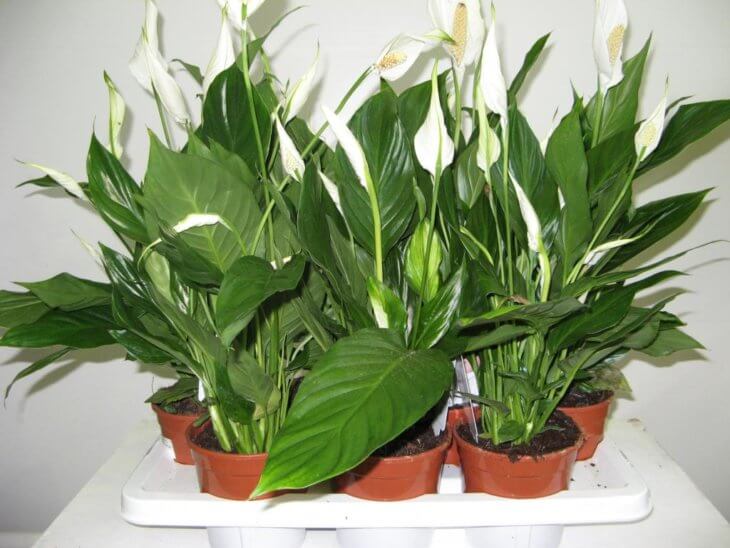

Healthy spathiphyllum grown in the right conditions
The flowerpot is in the wrong place. The place of growth significantly affects the development of the flower.
In summer, it must be protected from direct sunlight. In winter, it is advisable not to place near cold glasses and on a cold windowsill.
Insufficient humidity in the room. High humidity is one of the conditions for growing this indoor plant. It requires additional spraying.
But it is worth remembering that when treating a bush with a spray bottle, water should not be allowed to enter the inflorescences. This can lead them to rot, as a result of which the plant becomes weak.
Lack or excess of nutrients. Deficiency of organic and mineral substances can be caused by non-observance of the frequency of feeding.
Excess is usually caused by inappropriate dosage. Also, during the first application of fertilizers, it should be borne in mind that nutrient complexes with a prolonged action are introduced into the land substrate for sale. Therefore, after the first transplant, it is necessary to apply fertilizers no earlier than a month later.
Diseases and pests. They significantly reduce the immunity of the plant. Therefore, it is necessary to regularly inspect the soil in the flowerpot for the presence of fungus and mold.
Also, the outer and inner sides of the leaf, leaf sinuses and inflorescences are carefully examined for the presence of aphids, ticks or thrips.
Stagnant water and over-watering. Water in the flowerpot can accumulate in the absence of drainage holes at the bottom. Also, excessively moist soil can provoke the process of root rot. Especially if the flower is grown in a plastic pot.
The plant can only be helped by accurately establishing the cause of external changes in its aboveground part. To do this, it is necessary to assess the condition of the flower and indicate the mistakes that were made during the care.
How to get rid of black tips on spathiphyllum leaves:
If the soil in the flowerpot is not contaminated, you can dry it. To do this, a layer of peat is poured into the flowerpot.
Blooming spathiphyllum
When the soil mixture is covered with a bloom of white or green, it is necessary to transplant the flower.
At the same time, its root is carefully examined, black and rotten roots are removed. Cut points are treated with activated carbon powder. The bush is planted in a loose soil mixture in a new flowerpot.
With a deficiency of nutrients, it is enough to feed. It is necessary to use a complex for flowering plants or special fertilizers for spathiphyllum. If there is an excess of fertilizer, the frequency of application should be increased.
If harmful insects are found, it is necessary to treat the flower with special agents. To prevent re-infection, all other indoor plants are sprayed.
To quickly restore the plant, it is necessary to look for the cause of the blackening of the tips of the leaves at the very beginning of the process. Usually this is excessive soil moisture. Therefore, it is necessary to start with the normalization of watering.
Expert opinion
Yulia Yurievna
I have a large garden and vegetable garden, several greenhouses. I love modern methods of plant cultivation and soil mulching, I share my experience.
Ask a Question
Preventive measures
Prevention includes the simplest manipulations:
- maintaining a sufficient level of humidity;
- finding the plant only under diffused sunlight;
- the product of correct watering and dressing.
At the first signs of pests or diseases, the plant must be immediately processed and planted in new soil.
Before we start growing spathiphyllums at home, do not be afraid of the above problems. This plant is extremely unpretentious and therefore is able to actively grow and even bloom in the most unsuitable conditions for this. All that is required from the florist is attention to detail and a little patience.
Spathiphyllum leaves
The appearance of uneven dry brown spots on the leaves, asymmetric (mosaic) drying of the edges of the leaves, lethargy, especially in large-leaved tall varieties, can also be solved by correcting the care.
Sunburn is a typical reaction of spathiphyllum to too bright lighting with sunlight on sensitive leaves. It manifests itself in large, dry, unevenly scattered spots. There is only one way to deal with the problem - by moving to a new place with diffused lighting or installing a screen.
Useful video
We offer an informative video about yellowing of Spathiphyllum leaves:
If you find an error, please select a piece of text and press Ctrl + Enter.
Spathiphyllum in the common people is called "female happiness." This evergreen tropical plant has amazing beauty. In the wild, it grows along the shores of water bodies in South America and New Guinea.
The article will acquaint you with the amazing spathiphyllum plant, the rules of care and reproduction, and will give you some useful tips.
Description of the plant
This houseplant can be easily identified among the rest of the inhabitants of the winter garden. It does not have a stem, the leaves grow directly from the ground, have a rich green color. The middle vein is clearly visible on the leaf plate.
The flower is a yellowish-white ear, surrounded by a snow-white leaf, in the form of a drop, located on a high peduncle. The white bedspread is sometimes decorated with greenish blotches. During flowering, it acquires a uniform green color.
Popular varieties
Spathiphyllum is not only an ornamental plant, but also useful:
- able to clean the air of the room from the presence of toxic substances in it, such as: carbon monoxide, xylene, formaldehyde, trichlorethylene, benzene
- increases the humidity of the air, releasing into it substances that prevent the development of mold fungi.
Almost fifty varieties of Women's happiness are known to flower growers today, of which the most often found on window sills and in winter gardens:
Profusely blooming


It is a low bush. It has creamy flowers with a pleasant delicate aroma. The cover is much larger than the cob. It begins to bloom in March and ends in October. It was this feature that became the reason for such a name.
Wallis
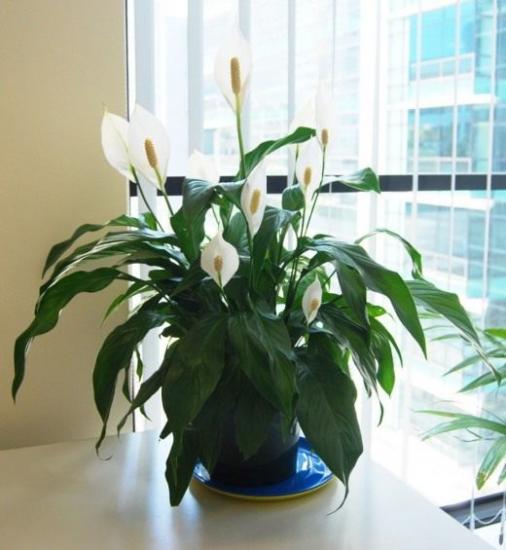

It is smaller in comparison with the richly flowering representative of this family. The flowers have narrow, elongated, pointed veils.
Canniferous


A snow-white blanket of a flower envelops an ear of yellow-green color. The leaves are large, their color is saturated, reminiscent of cannes. Has a pronounced aroma.
Charming
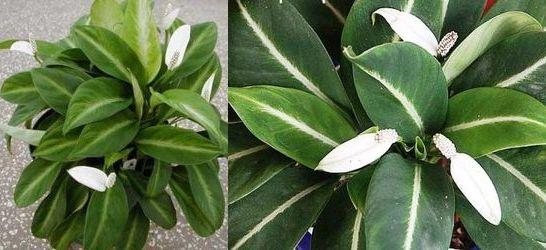

The plant has large, elongated leaves. The bedspread is greenish-white and resembles a flag. What was the reason for the second name "flagolite". It blooms profusely.
Heliconial
Representatives of this variety reach a height of up to one hundred centimeters. Their platinum plates have wavy edges, a glossy sheen, and are dyed dark green.The ear is almost two times smaller than the oval cover.
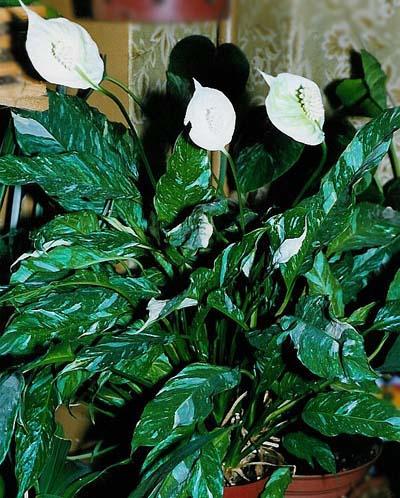

The presented species were used as a basis for breeding hybrid species, among which there are giants and dwarfs. Hybrid varieties are hardy, bloom for a long time and profusely.
Spathiphyllum: leaves turn black at the edges, what to do
If the leaves of your spathiphyllum begin to turn black, you need to carefully examine the plant, since such a process can be associated not only with improper care, but also with diseases.
First of all, you should decide which side of the sheet plate began to turn black. Since it is this symptom that is considered key, we will consider the main signs and causes of blackening in more detail.
Leaves at the tips turn black
If spathiphyllum leaves begin to blacken and dry out at the tips, chances are your plant is suffering from improper care. First of all, you need to check the moisture content of the substrate: perhaps your flower simply does not have enough moisture. But it should be borne in mind that excessive watering can cause this process. If the leaves turn black massively from an excess of moisture, you will have to transplant the flower into a new pot.
In addition, blackening of the tips of the leaves can be associated with an incorrectly selected substrate, drafts or an excess of fertilizers. In this case, you need to either replace the soil in the pot with a suitable one, or rearrange the spathiphyllum to a new place, away from cold air currents, and stop feeding for a while.
Leaves in the middle turn black
If negative environmental factors provoke blackening of the leaves along the edges, then the formation of dark spots in the middle of the leaf indicates a completely different process - a disease (Figure 3).


Figure 3. Symptoms of a fungal infection
As a rule, blackening of the leaves is associated with a fungal infection of the plant. Despite the fact that spathiphyllum loves warmth and moisture, with an increase in these indicators, fungal spores begin to spread through the air. They cause root and leaf rot, which is accompanied by the formation of dark spots. If this happens to your flower, immediately remove the affected parts and spray the plant with a fungicide. It is also necessary to inspect the substrate: if it is too wet, the culture must be transplanted into a pot with fresh soil.
Care rules
When buying a flower in a store specializing in the sale of indoor flowers, it must be transplanted, and this requires:
- prepare the ground thoroughly
- the soil mixture should consist of peat, sand, leafy soil and manure, taken in equal proportions. The mixture also contains ceramic chips and crushed birch charcoal.
- the pot in diameter should exceed the previous one by a couple of centimeters. It must be remembered that the flower needs to be transplanted once a year. The pot needs to be increased with each transplant.
- the hole designed to remove excess liquid must be covered with a shard with a bulge, and pebbles or expanded clay balls should be poured on top;
How to fix it?
As a rule, problems of this nature are associated with improperly organized care. Having figured out the possible causes of trouble, you should help the indoor exotic to restore its previous state.
When filling the soil
- Get the flower out of the pot, carefully examine and feel the root system.
- Cut dry, rotten roots.
- Disinfect the sections with ground cinnamon or crushed activated carbon.
- Treat the plant with a solution of the Maxim drug for prophylaxis.
- Transplant the flower into a new dry soil, also change the pot.
- Do not water immediately.
- A drainage layer is required.
- In the future, normalize the irrigation system.
- After moistening, after 15 minutes, drain excess liquid from the pan under the flowerpot.
Dry air


Normalize the temperature and humidity conditions in the room.- Use a humidifier regularly.
- Spray the leaves daily with a spray bottle.
- Perhaps place a flowerpot near the aquarium.
- Eliminate drafts and cold air on the flower.
- In winter, it is better to change the place of stay by removing it from the windowsill.
- Or cover heating appliances with a wet towel on a regular basis.
Diseases of spathiphyllum
Leaves turn yellow
What to do when the leaves of Women's happiness change their usual color to yellow? The reason for this is non-compliance with the watering regime: either the flower was not watered for a long time, or water was poured too often. For treatment, you need to streamline watering.


Another reason for the yellowing of foliage is the plant's need for vitamins and minerals. This flower usually suffers from magnesium deficiency. Feeding with magnesium sulfate will help him.
Leaves turn black
A similar phenomenon occurs when there is insufficient or excess fertilizer, when the air humidity in the room where the plant is located is low, when the plant is watered with the wrong water.
To prevent such manifestations, you need:
- fertilize the plant every ten days from spring to autumn, and only once in winter;
- water only with soft settled water;
- remember about water procedures - water the flower from the shower weekly;
- find a good spot for the spathiphyllum.
Flowers turn yellow or black
When such a sign appears, it is necessary to treat the soil with a foundation dissolved in water. Dissolve two drops of the drug in a liter of water and water the plant.
Leaves dry
When the leaves of a flower Feminine happiness begin to dry, it means that the room where it is located is too low humidity. Dry air is the main reason the leaves of the plant begin to dry out.
Spathiphyllums are often attacked by thrips, spider mites, mealybugs. Using regular soap and water will help get rid of harmful insects.
You just need to wash the foliage with the prepared solution. If a case of pest infestation has already been started, then you need to use special chemicals that can be bought at a flower shop.
If the listed methods did not help the Woman's happiness flower, and it continues to die, you can try to revive it in such a way as transplanting. Remove the plant from the pot. Soak an earthen ball and free the roots from the earth. Divide the bush into parts, if possible, and put each of them in an opaque container with water.
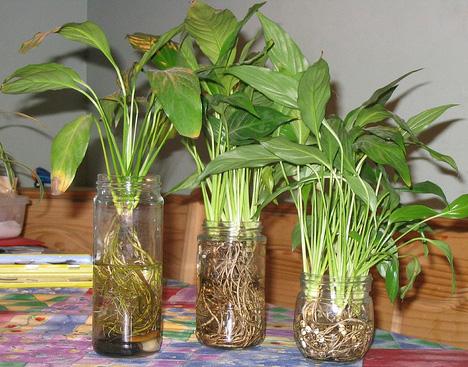

Plants should remain in the water until new roots begin to grow. Then they can be planted in a new substrate.
Suitable fertilizers
So that the leaves of the spathiphyllum do not turn yellow, you should feed the flower in time, alternating mineral preparations with organic matter. Women's happiness responds well to a light solution of fermented cow dung or bird droppings, one part of which is diluted in 30 parts of water. For spathiphyllum, organic-based ready-made feeds are sold, such as Magic Mix and Garden of Miracles. They must be entered following the instructions in the instructions.
Feminine happiness develops well thanks to Agricola. It is applied before flowering. During the flowering period they use Kemira Lux or Uniflor-Bud as top dressing.
Although the flower Women's happiness does not require enhanced care, it is still not immune from diseases and injuries, so you need to cherish and surround it with care. After all, only a healthy plant can please with good flowering.
We offer a video about the causes of yellowing of leaves in spathiphyllum:
Signs associated with the flower Women's happiness
This flower is called Women's happiness for a reason. It is believed that this houseplant can bring good luck and family well-being to its mistress. You cannot give your personal spathiphyllum to anyone, because in this way you will transfer your happiness into the wrong hands.
There is a sign that the desire will begin to be fulfilled when the bud opens.If the plant dries up, this is bad and is compared to a loss of happiness.
In a house in which there is a spathiphyllum, it is categorically impossible to quarrel and scandal. He feels negative energy and this causes him stress, which can lead to his death.
With careful handling of the plant, you can ask him to fulfill his wishes. In gratitude for the love and affection, the plant will fulfill the request. Women's happiness can be bought independently or received as a gift. You need to buy on Wednesday, Friday, Saturday - the so-called women's days. Only shoots can be gifted.
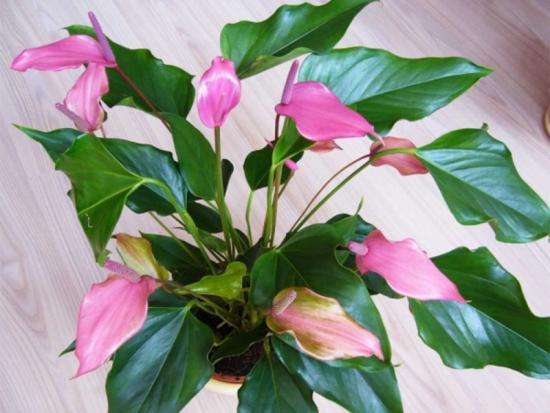

A flower specially purchased in order to give is able to help any woman to fulfill her desires. For example, an unmarried woman will find her love, a childless woman will become pregnant and give birth to a healthy child.
Growing spathiphyllum at home is not difficult. To do this, you need to properly care for him. Be loving and caring towards him, and he will respond in kind.
About why the leaves of spathiphyllum turn yellow and black and how to avoid such problems, in more detail - when watching the video:
What does spathiphyllum want?
Spathiphyllum "earned" the fame of an easy-to-grow plant. In order to avoid problems, it is enough to take care of a few points in the cultivation:
- choose a bright or semi-shaded place with diffused lighting, many spathiphyllums grow well even in the shade;
- monitor the temperature, the values of which, even in winter, should not fall below 16 degrees;
- protect the spathiphyllum from drafts, the proximity of heating devices and hypothermia of the pot;
- maintain a stable light moisture content of the substrate with restrained, abundant watering, do not allow water to stagnate in the pallets and always allow the soil to dry out in the upper layer;
- provide at least average air humidity;
- regularly shower and clean the leaves from dust;
- turn the plant in relation to the light source;
- apply top dressing from March to October with special fertilizers for decorative leafy plants every 2 weeks, but reducing the standard dosage. If spathiphyllums continue to bloom and grow in winter, it is worth reducing feeding, but not stopping them;
- transplant only as needed, in a high-quality loose substrate.
Read more about caring for a plant in the material Spathiphyllum, or "Women's happiness".
In order to never face the problem of drying the leaves of spathiphyllums, you just need to remember the golden rule of growing them - the more stable the environment, the more decorative the plant.


